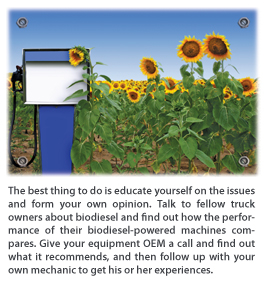Biodiesel 101

With growing demand for alternative fuels, the biomass market is quickly maturing. Construction and landscape equipment manufacturers are releasing news of biodiesel-ready machines, so alternative fuel producers are popping up across the country. New sources of biofuel are being discovered at an incredible rate, and a distribution network is being built to meet the supply and demand. As the market becomes popular, professionals will need to understand their alternatives in the expanding fuel source industry.
Navistar Engine Group understands and supports customer interest in renewable fuel resources used to produce biodiesel fuel and recognizes the rapidly growing biodiesel industry and government incentives. The company agrees with the official position of the Engine Manufacturers Association (EMA) on the use of biodiesel fuel and unconditionally warrants the use of biodiesel blends up to and including B5 meeting ASTM D6751 and ASTM D975 specifications. See www.enginemanufacturers.org for more information.
Biodiesel Blends Up to B5
Currently, all blends up to B5 have characteristics that are indistinguishable from diesel fuel. Work is under way to include specifications for blends up to B5 in the ASTM D975 standard. Navistar and other engine manufacturers approve of blends up to B5, provided that the two components satisfy current specifications ASTM D6751 and ASTM D975. Quality biodiesel blends up to B5 should not cause engine or fuel system problems.
Biodiesel Blends B6 to B20
Biodiesel blends B6 to B20 have different characteristics than diesel fuel. B20 is most widely used by fleets in the United States, because B20 balances performance, emission levels, costs and availability. B20 is also the minimum blend level that qualifies as an alternative fuel, in compliance with the Energy Policy Act of 1992. Blends lower than B20 are used regionally, depending on favorable tax incentives that vary from state to state.

Until the ASTM B6 to B20 standard is issued, the EMA B20 Test Fuel Specification is recommended for users requesting quality and consistency of B20 blends.
The National Biodiesel Board (NBB) has established a biodiesel BQ9000 Quality Management Program to train, certify and accredit all biodiesel producers and sellers. This program should significantly promote product quality and consistency in the emerging biodiesel industry. See www.nbb.org, for more information.
Biodiesel Blends Over B20
Navistar does not recommend biodiesel blends higher than B20; higher proportions of biodiesel in the blend can cause problems during engine operation.
Navistar Recommends the Following:
- Storage tanks should be thoroughly cleaned of residue and microbial growth before storing biodiesel fuel and tanks should be inspected periodically for cleanliness. Residue, water or microbial growth will compound in stored biodiesel fuel, causing increased fuel deposits that clog fuel filters prematurely. Adding biocides will reduce microbial growth during storage, but this is not a substitute for cleaning storage tanks.
- Vehicle fuel tanks should be thoroughly cleaned and dried before using biodiesel blends. Because biodiesel blends tend to dissolve deposits in fuel tanks and fuel lines, new fuel filters should be installed on used engines before using biodiesel blends.
- Fuel filters should be changed at half the service interval for the next two fuel filter changes after starting to use biodiesel. After this initial period, maintain the service interval specified in the engine operation and maintenance manual. In cold climate conditions, Navistar recommends that an appropriate fuel heater be installed.
- Water separation from biodiesel fuel blends is more difficult than water separation from diesel fuel. Users should be as careful as possible to prevent water from getting into the fuel system. If possible, an additional fuel filter should be installed in the fuel system to remove water.
- Biodiesel blends should be used within six months of the date of manufacture, because the oxidation stability of biodiesel is lower than diesel fuel. If equipment fueled with biodiesel is to be stored for more than three months, the fuel system should be drained, cleaned and dried. The following materials should be monitored if engines operate with biodiesel: natural rubber; butyl rubber; nitrile; copper; tin; and lead. These materials can degrade prematurely and cause deposits that clog fuel lines and filters.

Comments are closed here.